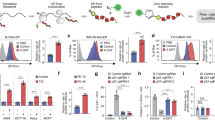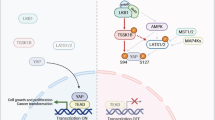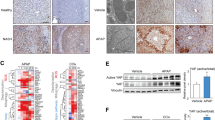Abstract
Werner syndrome (WS) results from dysfunction of the WRN protein, and is associated with premature aging and early death. Here we report that loss of WRN function elicits accumulation of the Yes-associated protein (YAP protein), a major effector of the Hippo tumor suppressor pathway, both experimentally and in WS-derived fibroblasts. YAP upregulation correlates with slower cell proliferation and accelerated senescence, which are partially mediated by the formation of a complex between YAP and the PML protein, whose activity promotes p53 activation. The ATM kinase is necessary for YAP and PML accumulation in WRN-depleted cells. Notably, the depletion of either YAP or PML partially impairs the induction of senescence following WRN loss. Altogether, our findings reveal that loss of WRN activity triggers the activation of an ATM-YAP-PML-p53 axis, thereby accelerating cellular senescence. The latter has features of SASP (senescence-associated secretory phenotype), whose protumorigenic properties are potentiated by YAP, PML and p53 depletion.
Similar content being viewed by others
Log in or create a free account to read this content
Gain free access to this article, as well as selected content from this journal and more on nature.com
or
Abbreviations
- WS:
-
Werner syndrome
- WRN:
-
Werner syndrome protein
- YAP:
-
Yes-associated protein
- PML:
-
Promyelocytic Leukemia protein
- SASP:
-
Senescence-associated secretory phenotype
- SA-β-Gal:
-
Senescence-associated β-galactosidase
- BrdU:
-
5-Bromo-2′-deoxy-uridine
References
Bachrati CZ, Hickson ID . RecQ helicases: guardian angels of the DNA replication fork. Chromosoma 2008; 117: 219–233.
Hanada K, Hickson ID . Molecular genetics of RecQ helicase disorders. Cell Mol Life Sci 2007; 64: 2306–2322.
Sharma S, Doherty KM, Brosh RM Jr . Mechanisms of RecQ helicases in pathways of DNA metabolism and maintenance of genomic stability. Biochem J 2006; 398: 319–337.
Soultanas P, Wigley DB . Unwinding the 'Gordian knot' of helicase action. Trends Biochem Sci 2001; 26: 47–54.
Yu CE, Oshima J, Fu YH, Wijsman EM, Hisama F, Alisch R et al. Positional cloning of the Werner's syndrome gene. Science 1996; 272: 258–262.
Goto M, Miller RW, Ishikawa Y, Sugano H . Excess of rare cancers in Werner syndrome (adult progeria). Cancer Epidemiol Biomarkers Prev 1996; 5: 239–246.
Hickson ID . RecQ helicases: caretakers of the genome. Nature reviews. Cancer 2003; 3: 169–178.
Opresko PL . Telomere ResQue and preservation--roles for the Werner syndrome protein and other RecQ helicases. Mec Ageing Dev 2008; 129: 79–90.
Sudol M, Bork P, Einbond A, Kastury K, Druck T, Negrini M et al. Characterization of the mammalian YAP (Yes-associated protein) gene and its role in defining a novel protein module, the WW domain. J Biol Chem 1995; 270: 14733–14741.
Bertini E, Oka T, Sudol M, Strano S, Blandino G . YAP: at the crossroad between transformation and tumor suppression. Cell Cycle 2009; 8: 49–57.
Strano S, Fausti F, Di Agostino S, Sudol M, Blandino G. PML . Surfs into HIPPO Tumor Suppressor Pathway. Frontiers Oncol 2013; 3: 36.
Lapi E, Di Agostino S, Donzelli S, Gal H, Domany E, Rechavi G et al. PML, YAP, and p73 are components of a proapoptotic autoregulatory feedback loop. Mol Cell 2008; 32: 803–814.
Strano S, Monti O, Pediconi N, Baccarini A, Fontemaggi G, Lapi E et al. The transcriptional coactivator Yes-associated protein drives p73 gene-target specificity in response to DNA Damage. Mol Cell 2005; 18: 447–459.
Coppe JP, Desprez PY, Krtolica A, Campisi J . The senescence-associated secretory phenotype: the dark side of tumor suppression. Annu Rev Pathol 2010; 5: 99–118.
Coppe JP, Patil CK, Rodier F, Sun Y, Munoz DP, Goldstein J et al. Senescence-associated secretory phenotypes reveal cell-nonautonomous functions of oncogenic RAS and the p53 tumor suppressor. PLoS Biol 2008; 6: 2853–2868.
Sliwinska MA, Mosieniak G, Wolanin K, Babik A, Piwocka K, Magalska A et al. Induction of senescence with doxorubicin leads to increased genomic instability of HCT116 cells. Mec Ageing Dev 2009; 130: 24–32.
te Poele RH, Okorokov AL, Jardine L, Cummings J, Joel SP . DNA damage is able to induce senescence in tumor cells in vitro and in vivo. Cancer Res 2002; 62: 1876–1883.
Pearson M, Carbone R, Sebastiani C, Cioce M, Fagioli M, Saito S et al. PML regulates p53 acetylation and premature senescence induced by oncogenic Ras. Nature 2000; 406: 207–210.
Oka T, Mazack V, Sudol M . Mst2 and Lats kinases regulate apoptotic function of Yes kinase-associated protein (YAP). J Biol Chem 2008; 283: 27534–27546.
Banin S, Moyal L, Shieh S, Taya Y, Anderson CW, Chessa L et al. Enhanced phosphorylation of p53 by ATM in response to DNA damage. Science 1998; 281: 1674–1677.
She QB, Chen N, Dong Z . ERKs and p38 kinase phosphorylate p53 protein at serine 15 in response to UV radiation. J Biol Chem 2000; 275: 20444–20449.
Sarkaria JN, Busby EC, Tibbetts RS, Roos P, Taya Y, Karnitz LM et al. Inhibition of ATM and ATR kinase activities by the radiosensitizing agent, caffeine. Cancer Res 1999; 59: 4375–4382.
Basu D, Reyes-Mugica M, Rebbaa A . Role of the Beta catenin destruction complex in mediating chemotherapy-induced senescence-associated secretory phenotype. PloS One 2012; 7: e52188.
Canino C, Mori F, Cambria A, Diamantini A, Germoni S, Alessandrini G et al. SASP mediates chemoresistance and tumor-initiating-activity of mesothelioma cells. Oncogene 2011; 31: 3148–3163.
Yang C, Robbins PD . The roles of tumor-derived exosomes in cancer pathogenesis. Clin Dev Immunol 2011; 2011: 842849.
Strano S, Munarriz E, Rossi M, Castagnoli L, Shaul Y, Sacchi A et al. Physical interaction with Yes-associated protein enhances p73 transcriptional activity. J Biol Chem 2001; 276: 15164–15173.
Yuan M, Tomlinson V, Lara R, Holliday D, Chelala C, Harada T et al. Yes-associated protein (YAP) functions as a tumor suppressor in breast. Cell Death Differ 2008; 15: 1752–1759.
Cioce M, Blandino G . PGC1alpha confers specificity-metabolic stress and p53-dependent transcription. Mol Cell 2011; 44: 515–516.
Barry ER, Morikawa T, Butler BL, Shrestha K, de la Rosa R, Yan KS et al. Restriction of intestinal stem cell expansion and the regenerative response by YAP. Nature 2013; 493: 106–110.
Zender L, Spector MS, Xue W, Flemming P, Cordon-Cardo C, Silke J et al. Identification and validation of oncogenes in liver cancer using an integrative oncogenomic approach. Cell 2006; 125: 1253–1267.
Zhao B, Kim J, Ye X, Lai ZC, Guan KL . Both TEAD-binding and WW domains are required for the growth stimulation and oncogenic transformation activity of yes-associated protein. Cancer Res 2009; 69: 1089–1098.
Zhao B, Ye X, Yu J, Li L, Li W, Li S et al. TEAD mediates YAP-dependent gene induction and growth control. Genes Dev 2008; 22: 1962–1971.
Zhao B, Li L, Lei Q, Guan KL . The Hippo-YAP pathway in organ size control and tumorigenesis: an updated version. Genes Dev 2010; 24: 862–874.
Zhao B, Li L, Wang L, Wang CY, Yu J, Guan KL . Cell detachment activates the Hippo pathway via cytoskeleton reorganization to induce anoikis. Genes Dev 2012; 26: 54–68.
Bhat KP, Salazar KL, Balasubramaniyan V, Wani K, Heathcock L, Hollingsworth F et al. The transcriptional coactivator TAZ regulates mesenchymal differentiation in malignant glioma. Genes Dev 2011; 25: 2594–2609.
Cordenonsi M, Zanconato F, Azzolin L, Forcato M, Rosato A, Frasson C et al. The Hippo transducer TAZ confers cancer stem cell-related traits on breast cancer cells. Cell 2011; 147: 759–772.
Sansone P, Storci G, Tavolari S, Guarnieri T, Giovannini C, Taffurelli M et al. IL-6 triggers malignant features in mammospheres from human ductal breast carcinoma and normal mammary gland. J Clin Invest 2007; 117: 3988–4002.
Moser R, Toyoshima M, Robinson K, Gurley KE, Howie HL, Davison J et al. MYC-driven tumorigenesis is inhibited by WRN syndrome gene deficiency. Mol Cancer Res 2012; 10: 535–545.
Neto-Silva RM, de Beco S, Johnston LA . Evidence for a growth-stabilizing regulatory feedback mechanism between Myc and Yorkie, the Drosophila homolog of Yap. Dev Cell 2010; 19: 507–520.
Ziv Y, Bar-Shira A, Pecker I, Russell P, Jorgensen TJ, Tsarfati I et al. Recombinant ATM protein complements the cellular A-T phenotype. Oncogene 1997; 15: 159–167.
Dimri GP, Lee X, Basile G, Acosta M, Scott G, Roskelley C et al. A biomarker that identifies senescent human cells in culture and in aging skin in vivo. Proc Natl Acad Sci USA 1995; 92: 9363–9367.
Szekely AM, Bleichert F, Numann A, Van Komen S, Manasanch E, Ben Nasr A et al. Werner protein protects nonproliferating cells from oxidative DNA damage. Mol Cell Biol 2005; 25: 10492–10506.
Moffat J, Grueneberg DA, Yang X, Kim SY, Kloepfer AM, Hinkle G et al. A lentiviral RNAi library for human and mouse genes applied to an arrayed viral high-content screen. Cell 2006; 124: 1283–1298.
Canman CE, Lim DS, Cimprich KA, Taya Y, Tamai K, Sakaguchi K et al. Activation of the ATM kinase by ionizing radiation and phosphorylation of p53. Science 1998; 281: 1677–1679.
Bernardi R, Scaglioni PP, Bergmann S, Horn HF, Vousden KH, Pandolfi PP . PML regulates p53 stability by sequestering Mdm2 to the nucleolus. Nature Cell Biol 2004; 6: 665–672.
Strano S, Munarriz E, Rossi M, Cristofanelli B, Shaul Y, Castagnoli L et al. Physical and functional interaction between p53 mutants and different isoforms of p73. J Biol Chem 2000; 275: 29503–29512.
Winter N, Nimzyk R, Bosche C, Meyer A, Bullerdiek J . Chromatin immunoprecipitation to analyze DNA binding sites of HMGA2. PloS One 2011; 6: e18837.
Vigneron AM, Vousden KH . An indirect role for ASPP1 in limiting p53-dependent p21 expression and cellular senescence. EMBO J 2012; 31: 471–480.
Turaga RV, Paquet ER, Sild M, Vignard J, Garand C, Johnson FB et al. The Werner syndrome protein affects the expression of genes involved in adipogenesis and inflammation in addition to cell cycle and DNA damage responses. Cell Cycle 2009; 8: 2080–2092.
Paronetto MP, Messina V, Bianchi E, Barchi M, Vogel G, Moretti C et al. Sam68 regulates translation of target mRNAs in male germ cells, necessary for mouse spermatogenesis. J Cell Biol 2009; 185: 235–249.
Acknowledgements
We thank Virginia Mazack for valuable comments on the first version of the manuscript. This work was supported by AIRC (no. 10454 to G B and no. 5954 to SS), by PA Breast Cancer Coalition Grants (no. 60707 and no. 920093) plus the Geisinger Clinic (to MS).
Author information
Authors and Affiliations
Corresponding authors
Ethics declarations
Competing interests
The authors declare no conflict of interest.
Additional information
Supplementary Information accompanies this paper on Cell Death and Differentiation website
Supplementary information
Rights and permissions
About this article
Cite this article
Fausti, F., Di Agostino, S., Cioce, M. et al. ATM kinase enables the functional axis of YAP, PML and p53 to ameliorate loss of Werner protein-mediated oncogenic senescence. Cell Death Differ 20, 1498–1509 (2013). https://doi.org/10.1038/cdd.2013.101
Received:
Revised:
Accepted:
Published:
Issue date:
DOI: https://doi.org/10.1038/cdd.2013.101
Keywords
This article is cited by
-
p53 shades of Hippo
Cell Death & Differentiation (2018)
-
Hippo/YAP signaling pathway is involved in osteosarcoma chemoresistance
Chinese Journal of Cancer (2016)
-
Promyelocytic leukemia protein enhances apoptosis of gastric cancer cells through Yes-associated protein
Tumor Biology (2015)
-
The mammalian Hippo pathway: regulation and function of YAP1 and TAZ
Cellular and Molecular Life Sciences (2015)
-
Chaetocin-induced ROS-mediated apoptosis involves ATM–YAP1 axis and JNK-dependent inhibition of glucose metabolism
Cell Death & Disease (2014)



